

The Begijnhof, Utrecht, was a beguinage (Dutch : Begijnhof) in the Dutch city of Utrecht.


The Begijnhof, Utrecht, was a beguinage (Dutch : Begijnhof) in the Dutch city of Utrecht.
The beguinage was located in the northern part of the city. The accepted[ by whom? ] date for the settlement there of the beguines is the second quarter of the 13th century. The enclosed but extensive site included a chapel, a groothuys ("big house") in multiple occupancy and a moeshof (communal garden). There were also a number of small houses which belonged to individual beguines. In addition, several more beguines lived to the south-east of the beguinage in an area called Het Heilige Leven ("The Holy Life"). There is no information on the precise number of beguines or on the details of their rule of life, but it seems likely that they were numerous. From about 1400 the Begijnhof was assured of the protection of begijnmeesters ("beguine masters") provided by the city, although the measure was as much about control as protection. In the 15th century various bishops and archbishops of Utrecht ordered the city to protect the beguines. [1]
After the Reformation (circa 1580) the Begijnhof increasingly lost its independence; in 1613 the beguines were forbidden to carry out Roman Catholic worship, and orders were passed concerning the transmission of property and the allocation of living spaces to Protestant townswomen. By about 1675 the Begijnhof had effectively ceased to exist, as in that year the sources of income of the few remaining beguines from the municipal authority were stopped. [1]

As the beguinage lost its independence the builders moved in on its site: new streets were laid out and new houses built. In the aftermath the Begijnekerk ("Beguine Church") was named after the previous beguinage, and some of the new streets, such as the Wijde Begijnestraat, owe their names to it. Of the original buildings of the Begijnhof very little remains: there are a few converted buildings or fragments reused from demolished ones. The chapel, after use as a stable, was converted to a dwelling house in about 1840; substantial parts of the structure are present in the house Wijde Begijnestraat 112. Also, the terrace of houses in the same street numbered 15-21 is in origin a house of the beguinage converted in about 1840. [1]

Holland is a geographical region and former province on the western coast of the Netherlands. From the 10th to the 16th century, Holland proper was a unified political region within the Holy Roman Empire as a county ruled by the counts of Holland. By the 17th century, the province of Holland had risen to become a maritime and economic power, dominating the other provinces of the newly independent Dutch Republic.

Utrecht University is a public research university in Utrecht, Netherlands. Established 26 March 1636, it is one of the oldest universities in the Netherlands. In 2018, it had an enrollment of 31,801 students, and employed 7,191 faculty and staff. In 2018, 525 PhD degrees were awarded and 6,948 scientific articles were published. The 2018 budget of the university was €857 million.
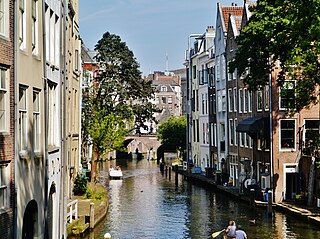
Utrecht is the fourth-largest city and a municipality of the Netherlands, capital and most populous city of the province of Utrecht. It is located in the eastern corner of the Randstad conurbation, in the very centre of mainland Netherlands; it has a population of 361,966 as of December 1, 2021.

The United Provinces of the Netherlands, also known as the United Provinces, officially as the Republic of the Seven United Netherlands, and commonly referred to in historiography as the Dutch Republic, was a federal republic which existed from 1588, during the Dutch Revolt, to 1795. It was a predecessor state of the Netherlands and the first fully independent Dutch nation state.

Turnhout is a Belgian municipality and city located in the Flemish province of Antwerp. The municipality comprises only the city of Turnhout proper. On January 1, 2015, Turnhout had a total population of 42,637. The total area is 56.06 km2 (21.64 sq mi) which gives a population density of 835.5/km2 (2,164/sq mi). The agglomeration, however, is much larger, accounting up to 81,473 inhabitants. Turnhout is known for its playing card industry, as it houses the head office of the world's largest manufacturer of playing cards, Cartamundi. Turnhout is also the capital of the administrative district with the same name. The Turnhout city council often promotes the city as "the capital of the Kempen area". This designation is entirely unofficial, since the Kempen area is far larger than the Turnhout district and does not form an administrative unit.
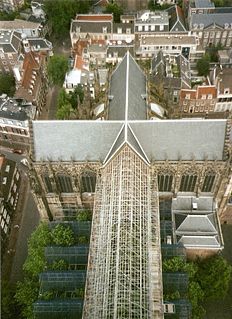
St. Martin's Cathedral, Utrecht, or Dom Church, is a Gothic church dedicated to Saint Martin of Tours, which was the cathedral of the Diocese of Utrecht during the Middle Ages. It is the country's only pre-Reformation cathedral, but has been a Protestant church since 1580.

Breda is a city and municipality in the southern part of the Netherlands, located in the province of North Brabant. The name derived from brede Aa and refers to the confluence of the rivers Mark and Aa. Breda has 184,762 inhabitants on 1 December 2021.
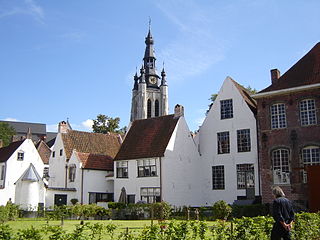
A beguinage, from the French term béguinage, is an architectural complex which was created to house beguines: lay religious women who lived in community without taking vows or retiring from the world.
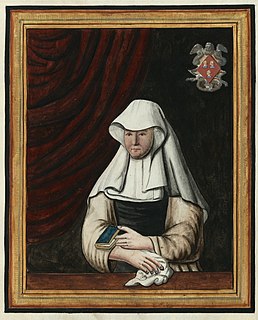
The Beguines and the Beghards were Christian lay religious orders that were active in Western Europe, particularly in the Low Countries, in the 13th–16th centuries. Their members lived in semi-monastic communities but did not take formal religious vows; although they promised not to marry "as long as they lived as Beguines," to quote one of the early Rules, they were free to leave at any time. Beguines were part of a larger spiritual revival movement of the 13th century that stressed imitation of Jesus' life through voluntary poverty, care of the poor and sick, and religious devotion.
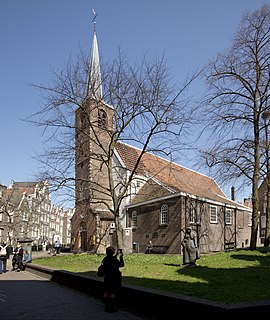
The English Reformed Church is one of the oldest buildings in Amsterdam, situated in the centre of the city. It is home to an English-speaking congregation which is affiliated to the Church of Scotland and to the Protestant Church in the Netherlands. It comes under the Church of Scotland's International Presbytery, and is also known as the Scots Kirk in Amsterdam. The current minister is Rev. Lance Stone.
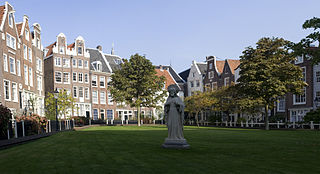
The Begijnhof is one of the oldest hofjes in Amsterdam, Netherlands. A group of historic buildings, mostly private dwellings, centre on it. As the name suggests, it was originally a Béguinage. Today it is also the site of two churches, the Catholic Houten Huys and the English Reformed Church.

The Holy Corner or Old Saint Elisabeth is a beguinage in Ghent, Belgium. It is one of three beguinages in the city – the other two are the new Saint Elisabeth beguinage in the suburb of Sint-Amandsberg and Our Lady Ter Hooyen in the Lange Violettenstraat. Both Saint Elisabeth beguinages were named after Elisabeth of Hungary, also known as Saint Elisabeth of Thuringia.

The Centraal Museum is the main museum in Utrecht, Netherlands, founded in 1838. The museum has a wide-ranging collection, mainly of works produced locally. The collection of the paintings by the Northern Mannerist Joachim Wtewael is by a long way the largest anywhere in the world. Other highlights are many significant paintings by the Utrecht Caravaggisti, such as Gerard van Honthorst and Hendrick ter Brugghen. Both of them travelled to Rome in the early 17th century to study the works of the Italian master Caravaggio. In the previous generation, as well as Wtewael, Abraham Bloemaert and the portraitist Paulus Moreelse were the most significant Utrecht painters, with Jan van Scorel still earlier.

The Groot Begijnhof of Leuven is a well preserved beguinage and completely restored historical quarter containing a dozen streets in the south of downtown Leuven. About 3 hectares in size, with some 300 apartments in almost 100 houses, it is one of the largest remaining beguinages in the Low Countries. It stretches on both sides of the river Dijle, which splits into two canals inside the beguinage, thus forming an island. Three bridges connect the parts of the beguinage. The complete beguinage is owned by the University of Leuven and used as a campus, especially for housing academics.
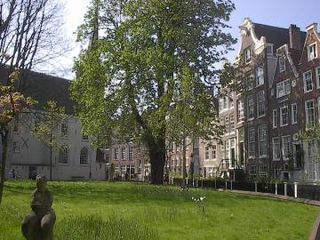
The Begijnhof Chapel, dedicated to Saint John and Saint Ursula, is a Roman Catholic chapel run by the Congregation of the Blessed Sacrament, in the St Nicholas Parish of Amsterdam. It is located in a former schuilkerk in the Begijnhof across from its original location, the English Reformed Church, Amsterdam. The Miracle of Amsterdam is commemorated yearly with a procession starting from this church.
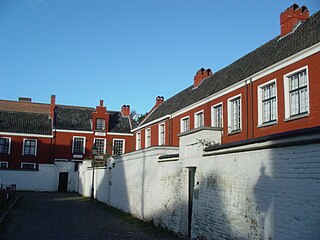
The small beguinage O.L.V. Ter Hooyen is situated in southern area of Ghent. This beguinage was built on the ‘Groene Hooie’, between the ‘Hooipoort’ and the ‘Vijfwindgatenpoort’. That is how this little beguinage got its name.

Kortrijk, sometimes known in English as Courtrai or Courtray, is a Belgian city and municipality in the Flemish province of West Flanders.

The Church of St. John the Baptist at the Béguinage is a Roman Catholic parish church in central Brussels, Belgium.
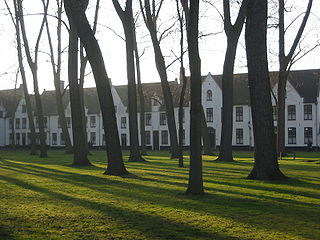
The Princely Beguinage Ten Wijngaerde is the only preserved beguinage in the Belgian city of Bruges. There are no more Beguines living there, but since 1927 it has functioned as a convent for Benedictines, founded by canon Hoornaert. In the same year the houses at the west side were also reshaped and enlarged into the Monasterium De Wijngaard, a priory of Benedictine nuns.
The Groot Begijnhof Sint-Amandsberg is an eight-hectare beguinage in the Sint-Amandsberg suburb just outside the centre of the Belgian city of Ghent. It was built between 1873 and 1874 on the abandonment of the Old Saint Elisabeth Beguinage in the city centre. There is also a third beguinage in Ghent, that of Our-Lady Ter Hooyen.
| Wikimedia Commons has media related to Begijnhof, Utrecht . |
Coordinates: 52°5′44.79″N5°7′18.08″E / 52.0957750°N 5.1216889°E